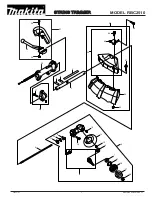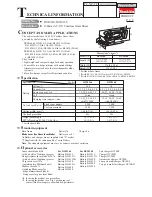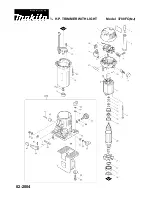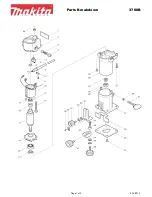
Each time the head is bumped, about 1 inch (25.4 mm) of trimming line releases. A
blade in the cutting head shield will cut the line to the proper length if any excess line
is released.
For best results, tap the bump knob on bare ground or hard soil. If attempting a line
release in tall grass, the engine may stall. Always keep the trimming line fully extended.
Line release becomes more difficult when the cutting line gets shorter.
NOTE:
Do not rest the Bump Head™ on the ground while the unit is running.
Some line breakage will occur from:
• Entanglement with foreign matter
• Normal line fatigue
• Attempting to cut thick, stalky weeds
• Forcing the line into objects such as walls or fence posts
TIPS FOR BEST TRIMMING RESULTS
• Keep the cutting head parallel to the ground.
• Do not force the cutting head. Allow the tip of the line to do the cutting, especially along walls. Cutting with more
than the tip will reduce cutting efficiency and may overload the engine.
• Cut grass over 8 inches (200 mm) by working from top to bottom in small increments to avoid premature line wear
or engine drag.
• Cut from right to left whenever possible. Cutting to the left improves the unit's cutting efficiency. Clippings are
thrown away from the operator.
• Slowly move the unit into and out of the cutting area at the desired height. Move either in a forward-backward or
side-to-side motion. Cutting shorter lengths produces the best results.
• Trim only when grass and weeds are dry.
• The life of the cutting line is dependent upon:
• Following the trimming techniques
• What vegetation is being cut
• Where vegetation is cut
For example, the line will wear faster when trimming against a foundation wall as
opposed to trimming around a tree.
DECORATIVE TRIMMING
Decorative trimming is accomplished by removing all vegetation around trees, posts, fences, etc..
Rotate the whole unit so that the cutting head is at a 30° angle to the ground (Fig. 12).
LINE INSTALLATION
This section covers both SplitLine® and standard
single line installation.
Always use original equipment manufacturer
0.095 in.
(2.41 mm)
replacement line. Line other than the
specified may make the engine overheat or fail.
There are two methods to replace the trimming line:
• Wind the inner reel with new line
• Install a prewound inner reel
Removing the Existing Inner Reel
1. Hold the outer spool with one hand and unscrew
the bump knob counterclockwise (Fig. 13).
Inspect the bolt inside the bump knob to make
sure it moves freely. Replace the bump knob if
damaged.
2. Remove the inner reel from the outer spool (Fig. 14).
3. Remove spring from the inner reel (Fig. 14).
4. Use a clean cloth to clean the the inner reel,
spring, shaft, and inner surface of the outer spool.
5. Check the indexing teeth on the inner reel and
outer spool for wear (Fig. 15). If necessary,
remove burrs or replace the reel and spool.
NOTE:
Always use the correct line length when
installing trimming line on the unit. The
line may not release properly if the line
is too long.
Single Line Installation
Go To Step 8 for SplitLine® Installation:
6. Take approximately 20 feet (6 m) of new
trimming line, loop it into two equal lengths.
Insert each end of the line through one of the
two holes in the inner reel (Fig. 16). Pull the line
through the inner reel so that the loop is as
small as possible.
7. Wind the lines in tight even layers onto the reel
(Fig. 17). Wind the line in the direction indicated
on the inner reel. Place an index finger between
the two lines to stop the lines from overlapping.
Do not overlap the ends of the line. Proceed to
step 12.
SplitLine® Installation
8. Take approximately 10 feet (3 m) of new trimming line. Insert one end of the line through one of the two holes in the
inner reel (Fig. 18). Pull the line through the inner reel until only about 4 inches is left out.
9. Insert the end of the line into the open hole in the inner reel and pull the line tight to make the loop as small as
possible (Fig. 18).
10. Before winding, split the line back about 6 inches.
11. Wind the line in tight even layers in the direction indicated on the inner reel.
NOTE:
Failure to wind the line in the direction indicated will cause the cutting head to operate incorrectly.
12. Insert the ends of the line into the two holding slots (Fig. 19).
13. Insert or slide the ends of the line through or into the eyelets in the outer spool and place inner reel with spring
inside the outer spool (Fig. 20). Push the inner reel and outer spool together.
NOTE:
The spring must be assembled on the inner reel before reassembling the cutting head.
14. While holding the inner reel and outer spool, grasp the ends and pull firmly to release the line from the holding slots in the spool.
15. Hold the inner reel in place and install the bump knob by turning clockwise. Tighten securely.
INSTALLING A PREWOUND REEL
1. Hold the outer spool with one hand and unscrew the bump knob counterclockwise (Fig. 13). Inspect the bolt inside
the bump knob to make sure it moves freely. Replace the bump knob if damaged.
2. Remove the old inner reel from the outer spool (Fig. 14).
3. Remove the spring from the old inner reel (Fig. 14).
4. Place the spring in the new inner reel.
NOTE:
The spring must be assembled on the inner reel before reassembling the cutting head.
5. Insert or slide the ends of the line through or into the eyelets in the outer spool (Fig. 20).
6. Place the new inner reel inside the outer spool. Push the inner reel and outer spool together. While holding the inner
reel and outer spool, grasp the ends and pull firmly to release the line from the holding slots in the spool.
7. Hold the inner reel in place and install the bump knob by turning clockwise. Tighten securely.
INSTALLATION OF THE SPEEDLOCK™
Removing the Existing Inner Reel
Refer to Removing the Existing Inner Reel in the Maintenance and Repair Insturctions section that can be found in the
operator’s manual.
Installing the SpeedLock™
1. After removing the inner reel, place the SpeedLock™ onto the shaft, making sure to align the arrows with the
eyelets in the outer spool (Fig. 21).
Loop
Fig. 16
Fig. 17
Loop
Fig. 18
Indexing Teeth
Fig. 15
Index Teeth
Fig. 19
Spring
Fig. 20
Eyelets
Bolt
Bump Knob
Fig. 13
4
2. Place the spring over the shaft and into the
recess in the SpeedLock™ Spool (Fig. 21).
3. While holding the outer spool in place, insert
the bolt located in the Bump Knob™ through
the end of the spring and into the end of the
shaft (Fig. 21).
4. While slightly compessing the spring, screw
the Bump Knob™ clockwise into the shaft (Fig.
21). Tighten Securely.
Installing the Trimming Line
1. Align the arrows on the SpeedLock™ with the
eyelets on the outer spool (Fig. 22).
2. Insert a piece of precut spiral line,
P/N
49UFSHLL953
, into an eyelet on the outer
spool (Fig. 22).
3. Push the line into the SpeedLock™ until it
starts to show from the opposite side.
4. Adjust the line so that both ends are of equal
length (Fig. 23).
5. While holding the outer spool in place, pull the
SpeedLock™ away from the outer spool and twist the SpeedLock™ clockwise until the dot is inline with the eyelet
or until it stops (Fig. 24).
6. Release the SpeedLock™ so that it snaps into place.
7. Check that the SpeedLock™ has seated completely into the outer spool. If it has not, repeat steps 5 thru 7.
Removing the Trimming Line
1. While holding the outer spool in place, pull the SpeedLock™ away from the outer spool and twist the SpeedLock™
counterclockwise until it stops. The arrows should align with the eyelets on the outer spool. (Fig. 22)
2. Release the SpeedLock™.
NOTE:
The SpeedLock™ should stand about 1/4 of an inch above the outer spool.
3. Firmly pull one end of the trimming line until the whole piece exits the outer spool.
REMOVING THE SPEEDLOCK™
1. While holding the outer spool in place, turn the Bump Knob™ counterclockwise until it completely unscrews from
the shaft.
2. Remove the spring.
3. Remove the SpeedLock™.
AIR FILTER MAINTENANCE
Cleaning the Air Filter
Clean the air filter every 10 hours of operation. It is
an important item to maintain. Failure to maintain
the air filter properly can result in poor performance
or can cause permanent damage to the engine.
1. Open the air filter cover by pressing the lock tab
in and pulling out on the air filter cover (Fig. 25).
2. Remove the air filter (Fig. 25).
3. Wash the filter in detergent and water (Fig. 26).
Rinse the filter thoroughly and allow it to dry.
4. Apply enough clean SAE 30 motor oil to lightly
coat the filter (Fig. 27).
5. Squeeze the filter to spread and remove excess
oil (Fig. 28).
6. Replace the air filter into the base plate (Fig. 25).
NOTE:
Operating the unit without the air filter
WILL VOID
the warranty.
7. Reinstall the air filter cover. Position the two
small tabs on the air filter cover into the two
slots in the base plate and press the air filter
cover down, making sure to align the lock tab with the lock tab slot, until it snaps into place (Fig. 25).
CARBURETOR ADJUSTMENT
The idle speed of the engine is adjustable. An idle adjustment screw is between the air filter cover and the engine
starter housing (Fig. 29).
NOTE:
Careless adjustments can seriously damage the unit. An authorized service dealer should make carburetor
adjustments.
Check Fuel Mixture
Old and/or improperly mixed fuel is usually the reason for improper unit performance. Drain and refill the tank with
fresh, properly-mixed fuel prior to making any adjustments. Refer to Oil and Fuel Information.
Clean Air Filter
The condition of the air filter is important to the operation of the unit. A dirty air filter will restrict air flow and change the
air/fuel mixture. This is often mistaken for an out of adjustment carburetor. Check the condition of the air filter before
adjusting the idle speed screw. Refer to Air Filter Maintenance.
Adjust Idle Speed Screw
If, after checking the fuel mixture and cleaning the air filter, the engine still will not idle, adjust the idle speed screw as follows:
1. Start the engine and run for one minute to warm up.
Refer to Starting/Stopping
Instructions.
2. Release the throttle trigger and let the engine idle. If the engine stops, insert a small
phillips screwdriver into the idle adjustment screw (Fig. 29). Turn the idle speed
screw
clockwise
1/8 of a turn at a time (as needed) until the engine idles smoothly.
3. If the engine appears to be idling too fast, turn the idle speed screw
counterclockwise
1/8 of a turn at a time (as needed), to reduce idle speed.
Checking the fuel mixture, cleaning the air filter and adjusting the idle speed should
solve most engine problems. If not and all of the following are true:
• the engine will not idle
• the engine hesitates or stalls on acceleration
• there is a loss of engine power
Have the carburetor adjusted by an authorized service dealer.
REPLACING THE SPARK PLUG
Use replacement #
753-06193
, a
Champion RDJ8J
spark plug, or equivalent. The correct air gap is
0.025 inch (0.635 mm)
.
Remove the plug after every 25 hours of operation and check its condition.
1. Stop the engine and allow it to cool. Grasp the plug wire firmly and pull it from the spark plug.
2. Clean around the spark plug. Remove the spark plug from the cylinder head by turning a 5/8-inch socket counterclockwise.
3. Replace a cracked, fouled or dirty spark plug. Set the air gap at
0.025 in. (0.635 mm)
using a feeler gauge (Fig. 30).
4. Install a correctly-gapped spark plug in the cylinder head. Tighten by turning the
5/8-inch socket clockwise until snug.
If using a torque wrench torque to:
110-120 in.•lb. (12.3-13.5 N•m)
Do not over tighten.
CLEANING
Use a small brush to clean off the outside of the unit. Do not use strong detergents. Household cleaners that contain
aromatic oils such as pine and lemon, and solvents such as kerosene, can damage plastic housing or handle. Wipe off
any moisture with a soft cloth.
STORAGE
• Never store a fueled unit where fumes may reach an open flame or spark.
• Allow the engine to cool before storing.
• Store the unit locked up to prevent unauthorized use or damage.
• Store the unit in a dry, well-ventilated area.
• Store the unit out of the reach of children.
LONG TERM STORAGE
If planning on storing the unit for an extended time, use the following storage procedure:
1. Drain all fuel from the fuel tank into a container with the same 2-cycle fuel mixture. Do not use fuel that has been
stored for more than 60 days. Dispose of the old fuel/oil mix in accordance to Federal, State and Local regulations.
2. Start the engine and allow it to run until it stalls. This ensures that all fuel has been drained from the carburetor.
3. Allow the engine to cool. Remove the spark plug and put 1 oz. (30 ml) of any high quality motor oil or 2-cycle oil
into the cylinder. Pull the starter rope slowly to distribute the oil. Reinstall the spark plug.
NOTE:
Remove the spark plug and drain all of the oil from the cylinder before attempting to start the unit after storage.
4. Thoroughly clean the unit and inspect it for any loose or damaged parts. Repair or replace damaged parts and
tighten loose screws, nuts or bolts. The unit is ready for storage.
MAINTENANCE AND REPAIR INSTRUCTIONS
WARNING:
To avoid serious personal injury, always turn the unit off and allow it to cool before you
clean or service it.
WARNING:
The cutting attachment will spin during idle speed adjustments. Wear protective clothing
and observe all safety instructions to prevent serious personal injury.
WARNING:
Do not sand blast, scrape or clean electrodes. Grit in
the engine could damage the cylinder.
Fig. 30
0.025 in.
(0.635 mm.)
WARNING:
Never use metal-reinforced line, wire, chain or rope. These can break off and become
dangerous projectiles.
Fig. 28
Fig. 26
Fig. 25
Fig. 27
Air Filter Cover
Air
Filter
Tab
Fig. 29
Idle Adjustment Screw
MAINTENANCE AND REPAIR INSTRUCTIONS
Outer Spool
Spring
Inner Reel
Fig. 14
MAINTENANCE SCHEDULE
Perform these required maintenance procedures at the frequency stated in the table. These procedures should also be
a part of any seasonal tune-up.
NOTE:
Some maintenance procedures may require special tools or skills. If you are unsure about these procedures
take your unit to any non-road engine repair establishment, individual or authorized service dealer.
NOTE:
Maintenance, replacement, or repair of the emission control devices and system may be performed by any
non-road engine repair establishment, individual or authorized service dealer.
WARNING:
To prevent serious injury, never perform maintenance or repairs with unit running. Always
service and repair a cool unit. Disconnect the spark plug wire to ensure that the unit cannot start.
FREQUENCY
MAINTENANCE REQUIRED
SEE
Before starting engine
Fill fuel tank with fresh fuel
p. 3
Every 10 hours
Clean and re-oil air filter
p. 4
Every 25 hours
Check spark plug condition and gap
p. 4
Outer Spool
Fig. 21
Trimmer
Line
Fig. 22
Eyelet
Shaft
Arrow
Eyelet
SpeedLock™
Spring
Recess
Bump
Knob™
Trimmer
Line
Fig. 23
Even
Cutting Head
Fig. 24
Dot
SpeedLock™
Eyelet
Fig. 12
OPERATING INSTRUCTIONS
Fig. 11
WARNING:
To avoid serious personal injury, always turn the unit off and allow it to cool before you
clean or service it.


































